A nostril accessory that melts away fat overnight while erasing cellulite, boosting metabolism, and clearing respiratory issues with the magic of concentrated bee venom. It sounds too good to be true – because it is. The hype surrounding the GGPM Bee Venom Nose Ring plays on desperate hopes, but a thorough investigation of this supposed wondrous honeybee nostril accessory reveals an ugly truth…
This so-called miracle product is nothing but an exploitative sham, crafted through devious formulas aimed to deceive, not heal. Outlandish promises contradict medical science. Company details are shrouded in secrecy. Reviews and photos are cleverly fabricated. Sales tactics pressure and mislead. And paying victims are left without answers or recourse when the harsh reality sets in.
The GGPM Bee Venom Nose Ring is a cautionary tale of how an elaborate web of lies can be spun to take advantage of vulnerabilities and insecurities. But understanding the calculated deception behind this scam arms us with knowledge to recognize these scams, guard our wellbeing, and prevent these frauds from capitalizing on despair.
By digging into the methods and evidence exposing this dangerous hoax, we can unravel its fabricated claims and equip ourselves to avoid becoming its next victim. The remains of this elaborate ruse provide invaluable insights into the effort that goes into deceiving hopeful consumers…and how their hopes can be preyed upon for profit.
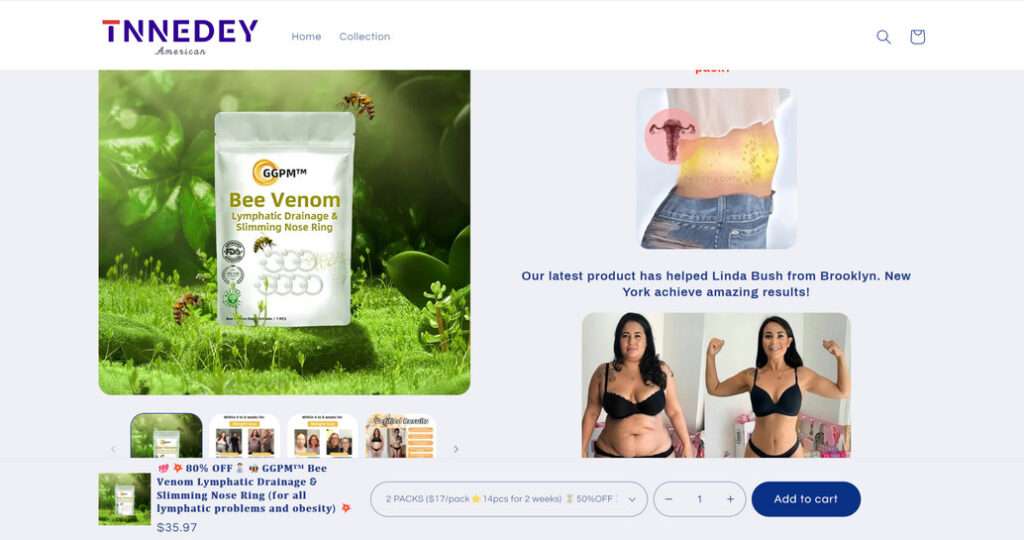
This Article Contains:
An Overview of the Elaborate GGPM Bee Venom Nose Ring Scam
At first glance, the GGPM Bee Venom Nose Ring seems like a revolutionary remedy for weight loss and respiratory issues. Slick social media ads portray it as a “breakthrough” treatment using bee venom to melt fat, detox the lymphatic system, erase cellulite, and boost metabolism overnight.
Dramatic before/after photos show both men and women shedding weight rapidly to achieve toned, slimmer physiques. The product is even endorsed by seemingly legitimate doctors and medical journals. And for the low price of $79.99, this nostril accessory offers a natural alternative to expensive liposuction procedures.
But here’s the harsh truth – the GGPM Bee Venom Nose Ring is a complete scam designed to swindle consumers. An investigation into the company reveals:
- There is no scientific proof that bee venom provides these benefits
- Medical claims are exaggerated and even contradict known facts
- Reviews are completely fabricated using AI review farms
- Before/after photos are stolen and edited to create illusions
- The manufacturers are untraceable offshore entities
- Addresses, contact details, and other specifics are totally obscured
In other words, everything about this company and its “miracle” bee venom nose ring is an elaborate hoax orchestrated to dupe buyers out of their money.
How the GGPM Bee Venom Nose Ring Scam Operates
The perpetrators of the GGPM scam have devised an intricate system to peddle their bogus product while evading responsibility. Here’s exactly how their deceptive scheme works at every stage:
1. Create Exaggerated Claims and Fake Backstories
To sell the illusion of a “miraculous” bee venom nose ring, the scammers concoct exaggerated claims about its effects. These include promises of rapid fat burning, cellulite removal, detoxification, respiratory relief, and more.
They falsify backstories about “accidentally” discovering the benefits of bee venom through independent research. And fake quotes are attributed to nonexistent doctors who tout the product’s effectiveness.
2. Manufacture Fake Positive Reviews
To make the product seem legitimate, the scammers use AI review farms and paid freelance services to generate hundreds of 5-star, glowing reviews.
These fake reviews praise the rapid results and life-changing benefits of the GGPM nose ring using similar narratives and language. Some pretend to be doctors endorsing it.
3. Doctor Images and Create Dramatic Before/After Photos
One of the most deceptive tactics used is posting dramatic before/after weight loss images that are complete fabrications. The scammers steal stock images online and then digitally alter them to make it seem as if the nose ring produced drastic results.
Some images are edited to make bodies appear slimmer and more toned. Others show radical 70-80 pound losses in implausible timeframes like 6 weeks. But none are real.
4. Set Up Websites and Funnel Pages With Fake Scarcity
The scammers create official-looking sites advertising the GGPM nose ring with more fake reviews and doctored before/afters.
These sites use countdown timers, limited inventory claims, and other phony marketing tactics to manufacture scarcity and a fear of missing out. This pressures victims to buy the bogus product.
5. Hide Behind Shell Companies and Offshore Entities
While some websites list details about the GGPM company, none of this can be verified. The addresses point to vacant lots or random buildings. Phone numbers are out of service or routed abroad.
The manufacturers hide behind complex corporate shells and offshore banking to conceal identities and avoid legal repercussions.
6. Keep All Sales Final and Prevent Returns
Victims who realize they’ve been scammed have no recourse for returns or refunds. The GGPM websites have ironclad “no returns” policies, and emails to their fake customer service addresses go unanswered.
This prevents buyers from obtaining refunds from the nonexistent company and keeps all sales final.
7. Shut Down and Rebrand Products Under New Names
To continue evading authorities, the scammers constantly shut down websites, remove traces, and then rebrand the same fake product under new names.
The nostril accessories may be remarketed as “LymphaSlim Rings,” “Sting nostrils,” or other monikers while retaining the same fictitious claims. The cycle continues ensnaring new victims.
This complex process allows the sophisticated scammers to operate the GGPM bee venom nose ring scam seamlessly while avoiding being caught.
Repackaged and Resold Under Other Brand Names
A common tactic used by these scammers is repackaging the same bogus GGPM Bee Venom Nose Ring under new names and brands to keep the scam going.
Investigations reveal the nose ring is resurfaced on ecommerce sites and social media using brands like Lotmay, Raindew, Seurico, SEAGRIL, GOFOUK, and others.
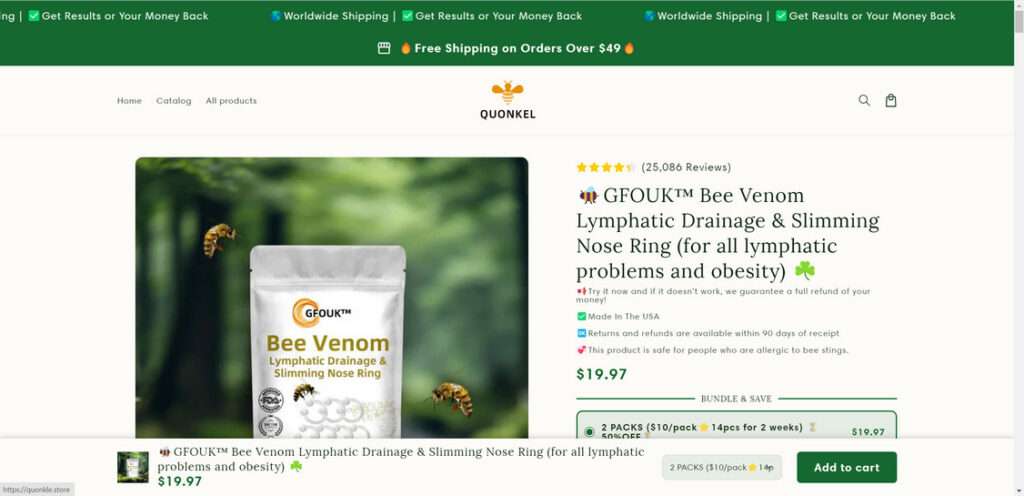
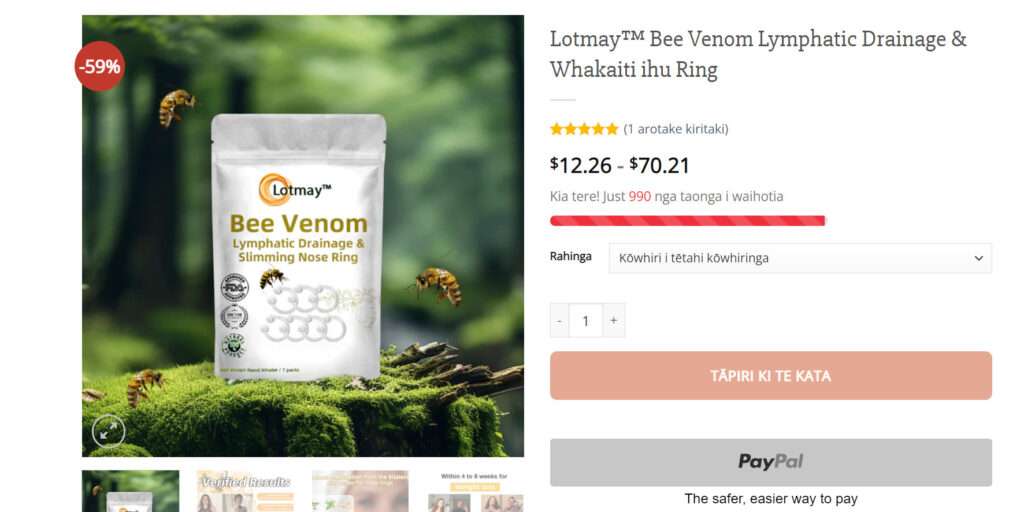
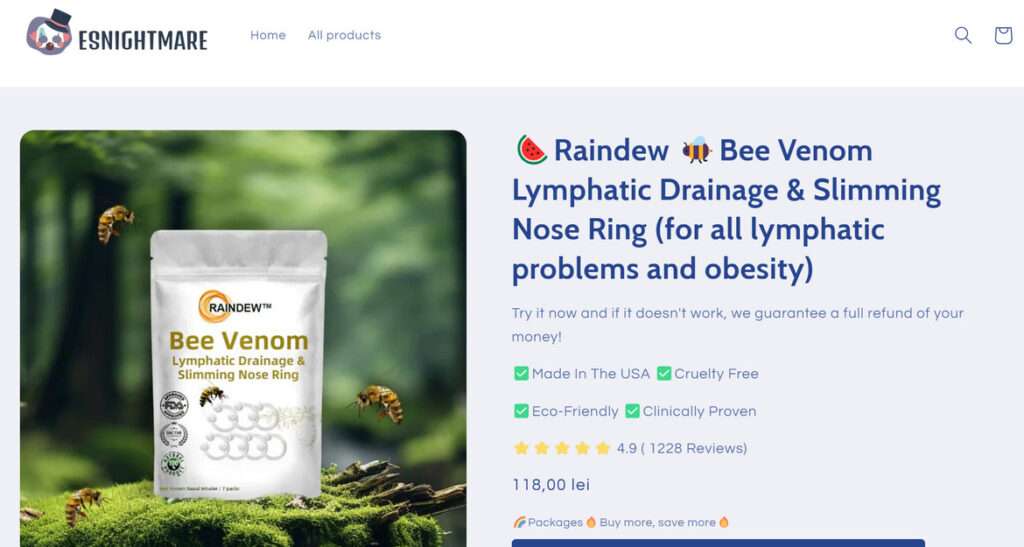
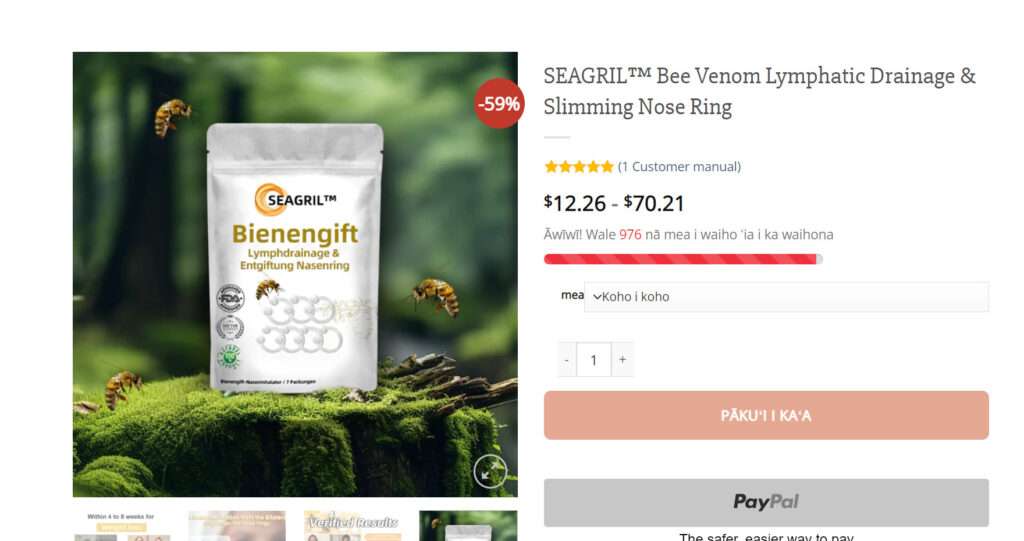
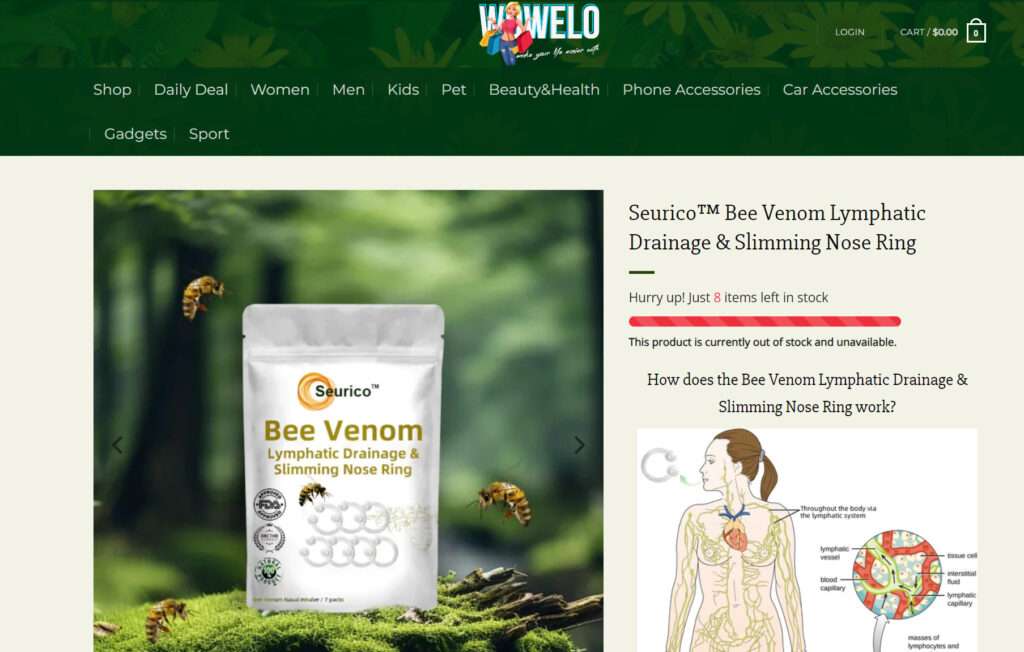
These brands feature the same fake reviews, doctored images, and outlandish claims about bee venom weight loss benefits. Some even use identical wording lifted from the original GGPM pages.
This rebranding ploy allows the scammers to continue peddling their fraudulent product to new victims while evading detection.
Those who wise up to the GGPM scam can still fall prey as these “new” brands promote the same nostril accessory.
It’s the same playbook, same deceitful formulas, but with different packaging. So consumers must stay vigilant for not just GGPM, but also its many rebranded iterations like Lotmay, Raindew, and others.
The harsh truth remains unchanged – it’s the same counterfeit product making false promises. And unfortunately, repackaging frauds is far too common with shady online health scams.
What To Do If You’re A Victim of the GGPM Bee Venom Nose Ring Scam
If you discover you’ve been deceived by the phony GGPM nose ring advertisements or purchased the product, take the following steps immediately:
- Stop Using the Product: Discontinue wearing the nostril ring and discard it to prevent any harm from mystery ingredients. Seek medical help if you experience any side effects.
- Report it: File detailed reports about the scam with the FTC, BBB, social media outlets used, and your local consumer protection agency.
- Warn Others: Leave online reviews on sites like TrustPilot to expose the scam to potential victims. Make posts with details on social media using awareness hashtags.
- Dispute Charges: Call your credit card company and bank to report fraudulent charges and request a chargeback. Provide any screenshots and order details.
- Gather Information: Save any emails, fake reviews, website details, or other evidence about the GGPM company and product to aid investigations.
- Seek Legal Action: Consulting with a consumer protection lawyer to explore legal remedies and joining class action lawsuits against the scammers.
- Learn From This: Research products thoroughly before buying. Consult doctors for medical treatments, not social media ads. Avoid falling for sensational claims and miracles.
Frequently Asked Questions
1. What is the GGPM Bee Venom Nose Ring?
The GGPM Bee Venom Nose Ring is a fraudulent product marketed online as a weight loss, cellulite reduction, and respiratory aid solution. However, it has been exposed as a complete scam making false claims about bee venom benefits. There is no credible evidence it provides any of the promised results.
2. How does the GGPM nose ring supposedly work?
The scammers behind this fraud claim the ring’s bee venom can melt fat, detox the lymphatic system, erase cellulite, and boost metabolism overnight. But these are medically unsupported claims that contradict scientific facts about bee venom’s properties and potency.
3. What proof is there that this is a scam?
There is overwhelming evidence this is a scam, including exaggerated claims, fake doctored photos, AI-generated false reviews, lack of company transparency, targeting of vulnerable demographics, refusal to issue refunds, and repackaging under new names.
4. Are the reviews and testimonials real?
No, the reviews are completely fabricated using AI review farms and freelance services. The scammers pay for fake 5-star reviews to boost perceived legitimacy. But the similar narratives expose their artificial origins.
5. Can it really provide the benefits and results claimed?
No, there is zero scientific proof bee venom can produce rapid weight loss, perfectly remove cellulite, or cure respiratory conditions. The dramatic claims blatantly defy medical facts about what bee venom can realistically achieve.
6. What company sells the GGPM Bee Venom nose ring?
There is no verifiable company behind it. The sellers use offshore entities, fake addresses, and anonymity to avoid being identified or held legally accountable for the scam.
7. Are the before and after pictures real results?
No, the photos are stolen stock images or Photoshopped fabrications. Reverse image searches reveal none are genuine customer results.
8. Where is the GGPM nose ring manufactured?
There are no legitimate laboratories or facilities manufacturing this product. The sellers are untraceable offshore entities using fictitious claims about research and manufacturing.
9. How much does the GGPM Bee Venom nose ring cost?
Prices range from $50 to $100, with fake discounts and sales pressure tactics to manufacture urgency. The price fluctuates wildly because the scammers are the only ones setting it.
10. Can I get a refund if I realize it’s a scam?
No, they refuse refunds and returns to prevent victims from recovering their money. Their websites have ironclad no return policies specifically to maximize profits from the fraud.
11. Is this bee venom collected humanely?
Their claims about “humane” venom extraction are fictitious since no actual bee venom production exists. However, even if it did, the concentrations claimed would be impossible to attain humanely.
12. How can I avoid falling for this scam?
Be skeptical of dramatic health claims, research companies thoroughly, consult doctors before buying, always check for fabricated reviews and photos, avoid publicized “miracle” treatments, and recognize high-pressure sales gimmicks.
The Bottom Line on the GGPM Bee Venom Nose Ring
The bottom line is clear – the GGPM Bee Venom Nose Ring is unequivocally a fraud. All evidence points to an intricate scam designed by unscrupulous con artists to swindle and take advantage of consumers.
From exaggerated claims to outright fake reviews and photos, nothing about this product is remotely legitimate. No real scientific evidence orapproval exists. The companies selling it are essentially ghost entities designed to evade the law.
While scams may be getting more advanced, a skeptical eye can discern their deceptive formulas. We hope this expose has revealed their predatory tactics so you can avoid becoming the next victim. Don’t let promises of shortcuts or miracles blind you – if it seems too good to be true, it almost always is.
This article is for educational purposes only and does not constitute professional, financial or legal advice. The content is intended for general information and should not be construed as definitive guidance. Information contained herein is subject to change without notice. For concerns, please contact us via the provided form. If you are the owner of the website or product in question and wish to offer clarifications regarding your business or website, please reach out to us through the provided Contact Form.










